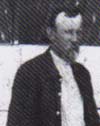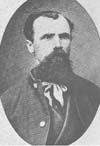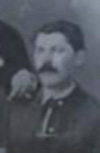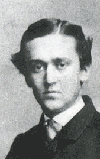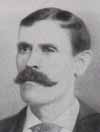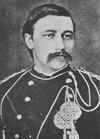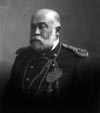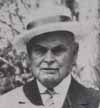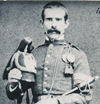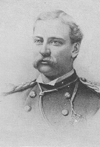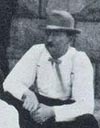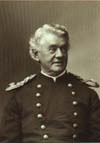Charles Adelbert Crandall died on April 23, 1885, in New York City and was buried in the Brookdale Cemetery in Brookdale, Pennsylvania. He was a Corporal with Company C who was not present at the battle because he was on detached service at the Powder River Depot.
William James Bailey (left), who was also known as William Baker, was born in Alexandria, Virginia, on April 24, 1850. He was a Private and served as a scout. He was not present at the battle because he was on the steamer Far West.
George Anson Merritt (left) died on April 24, 1918, in Chicago, Illinois, and was buried in the Elmwood Cemetery and Mausoleum in River Grove, Cook County, Illinois. He was a Private with the Band and, therefore, was not at the battle.
Jasper Rudolph Marshall was born on April 26, 1852, in Spring Valley, Ohio. He was a Private with Company L who was with the pack train and participated in the hilltop fight during the battle.
James Phillip McNally died in St. Paul, Ramsey County, Minnesota, on April 26, 1893, and was buried in Calvary Cemetery in St. Paul. He was a Private with Company I who was with the pack train and participated in the hilltop fight.
William R. Oman died on April 26, 1901, in Fargo, North Dakota, and was buried in the Riverside Cemetery there. He was a Private with Company D who participated in the hilltop fight. His third wife was named Cora; a Cora Oman was arrested six months later for selling liquor from a road house in Fargo.
Benjamin Franklin Burdick was born on April 27, 1851, in Grafton, Rensselaer County, New York. He was a Private with Company A who was not present at the battle because he was on detached service at Powder River, Montana.
Henry Armstrong “Autie” Reed (left) was born in Monroe, Michigan, on April 27, 1858. He was a civilian who was hired to accompany the Seventh on the campaign. He was the son of Lydia Custer Reed, the half-sister of George, Tom, and Boston Custer.
George Hose was born on April 29, 1850, in Hesse Cassel, Germany. He was a Corporal with Company K who participated in the hilltop fight.
Morris Cain was born on April 29, 1857, in Pittsfield, Massachusetts. He was a Private in Company M who participated in the valley and hilltop fights.
Treaty of Fort Laramie with the Sioux was signed on April 29, 1868.
Latrobe Bromwell died on April 29, 1923, in Washington, D.C., and was buried in the Soldiers’ Home National Cemetery. He was a Private in Company E who was not present at the battle because he became ill on Rosebud Creek and was sent back to the Powder River Depot. Those in his company who went to battle were killed.

